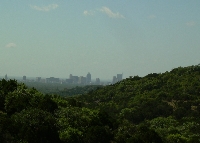
The Problem With Central Texas' Air Quality:
Ozone
Although air quality encompasses a wide variety of issues,
one key challenge to the Central Texas region is
ground-level ozone pollution. The Clean Air Partners program
is centrally focused on the reduction of pollutants that
form ground-level ozone in order to improve regional air
quality in Central Texas.
Ozone: The Threat is Real
 The U.S. Environmental Protection Agency (EPA) has
established standards for unhealthy airborne pollutants. In
Central Texas, ground-level ozone is the pollutant of
primary concern. Ozone also occurs naturally in the upper
atmosphere and protects us from harmful solar radiation, but
ground-level ozone is formed when man-made emissions of NOx
(Nitrogen Oxides) and VOC (Volatile Organic Compounds)
combine and “cook” in the sun, mainly during the
summertime. Ozone is produced in greater volumes on hot,
sunny days when there is little wind.
The U.S. Environmental Protection Agency (EPA) has
established standards for unhealthy airborne pollutants. In
Central Texas, ground-level ozone is the pollutant of
primary concern. Ozone also occurs naturally in the upper
atmosphere and protects us from harmful solar radiation, but
ground-level ozone is formed when man-made emissions of NOx
(Nitrogen Oxides) and VOC (Volatile Organic Compounds)
combine and “cook” in the sun, mainly during the
summertime. Ozone is produced in greater volumes on hot,
sunny days when there is little wind.
The two major pollutants, NOx and VOC, react with the sun’s heat to create ozone. Most of our region’s NOx and VOC emissions come from commuting vehicles, construction/site equipment and other business practices. Ozone takes time to form, and as the daytime temperature increases, the levels build. This makes vehicle emissions from the morning rush a major contributing factor to regional ozone levels for the rest of the day.
 Ground-level ozone is a serious threat to the health, the
economy and livability within the region. This invisible
pollutant hovers at our level, endangering our health and
impairing our breathing, with the greatest risks on our
children, the elderly and those suffering from lung related
illnesses. High ozone days (Ozone Action Days) can
also impact healthy people that are active and working
outdoors. Furthermore, federal regulations to reduce ozone
pollution can threaten our economy and impose mandatory
restrictions on the way we do business….actions that have
already impacted other metropolitan areas around the nation.
Ground-level ozone is a serious threat to the health, the
economy and livability within the region. This invisible
pollutant hovers at our level, endangering our health and
impairing our breathing, with the greatest risks on our
children, the elderly and those suffering from lung related
illnesses. High ozone days (Ozone Action Days) can
also impact healthy people that are active and working
outdoors. Furthermore, federal regulations to reduce ozone
pollution can threaten our economy and impose mandatory
restrictions on the way we do business….actions that have
already impacted other metropolitan areas around the nation.
Regulating Our Ozone
The Federal Clean Air Act requires that all metropolitan areas maintain standards (allowable levels) for ground-level ozone. The EPA monitors regional air quality and classifies areas that exceed these ozone levels as "nonattainment areas." Nonattainment areas are required to develop plans to improve air quality with EPA-mandated roadway funding restrictions, vehicle emissions testing, and limits on new business-related emissions. Central Texas has had recent violations of the EPA 8-hour standard for ground-level ozone. Repeated violations could force our region to be designated as nonattainment in the near future.
 In an effort to avoid these violations and designation, our
region has put forth early action efforts within Central
Texas (the Clean Air Partners Program being one of those),
working to reduce our ozone levels in an effort to avoid a
nonattainment designation. Since 2001, area officials and
stakeholders have come together to develop programs and
plans to deal with our ozone issue. Clean Air Partners also
began in 2001 as a way to encourage businesses to take
action and make an impact. In 2002, the Ozone Flex
Agreement was formed to address the 1-hour ozone standard,
followed by the Early Action Compact and Clean Air Action
Plan (2002-2007) to address the 8-hour ozone standard.
Currently, the 8-hour Ozone (O3) Flex Agreement, or “8-O3
Flex” reports ongoing efforts under the 8-hour standard.
The 8-O3 Flex reports voluntary emission reductions achieved
by local government efforts. A key component of these
voluntary reductions is the employer impact on ozone via
on-site and commute-related emissions (i.e. the actions of
Clean Air Partners).
In an effort to avoid these violations and designation, our
region has put forth early action efforts within Central
Texas (the Clean Air Partners Program being one of those),
working to reduce our ozone levels in an effort to avoid a
nonattainment designation. Since 2001, area officials and
stakeholders have come together to develop programs and
plans to deal with our ozone issue. Clean Air Partners also
began in 2001 as a way to encourage businesses to take
action and make an impact. In 2002, the Ozone Flex
Agreement was formed to address the 1-hour ozone standard,
followed by the Early Action Compact and Clean Air Action
Plan (2002-2007) to address the 8-hour ozone standard.
Currently, the 8-hour Ozone (O3) Flex Agreement, or “8-O3
Flex” reports ongoing efforts under the 8-hour standard.
The 8-O3 Flex reports voluntary emission reductions achieved
by local government efforts. A key component of these
voluntary reductions is the employer impact on ozone via
on-site and commute-related emissions (i.e. the actions of
Clean Air Partners).
Ozone: The Threat is Real
 The U.S. Environmental Protection Agency (EPA) has
established standards for unhealthy airborne pollutants. In
Central Texas, ground-level ozone is the pollutant of
primary concern. Ozone also occurs naturally in the upper
atmosphere and protects us from harmful solar radiation, but
ground-level ozone is formed when man-made emissions of NOx
(Nitrogen Oxides) and VOC (Volatile Organic Compounds)
combine and “cook” in the sun, mainly during the
summertime. Ozone is produced in greater volumes on hot,
sunny days when there is little wind.
The U.S. Environmental Protection Agency (EPA) has
established standards for unhealthy airborne pollutants. In
Central Texas, ground-level ozone is the pollutant of
primary concern. Ozone also occurs naturally in the upper
atmosphere and protects us from harmful solar radiation, but
ground-level ozone is formed when man-made emissions of NOx
(Nitrogen Oxides) and VOC (Volatile Organic Compounds)
combine and “cook” in the sun, mainly during the
summertime. Ozone is produced in greater volumes on hot,
sunny days when there is little wind.The two major pollutants, NOx and VOC, react with the sun’s heat to create ozone. Most of our region’s NOx and VOC emissions come from commuting vehicles, construction/site equipment and other business practices. Ozone takes time to form, and as the daytime temperature increases, the levels build. This makes vehicle emissions from the morning rush a major contributing factor to regional ozone levels for the rest of the day.
 Ground-level ozone is a serious threat to the health, the
economy and livability within the region. This invisible
pollutant hovers at our level, endangering our health and
impairing our breathing, with the greatest risks on our
children, the elderly and those suffering from lung related
illnesses. High ozone days (Ozone Action Days) can
also impact healthy people that are active and working
outdoors. Furthermore, federal regulations to reduce ozone
pollution can threaten our economy and impose mandatory
restrictions on the way we do business….actions that have
already impacted other metropolitan areas around the nation.
Ground-level ozone is a serious threat to the health, the
economy and livability within the region. This invisible
pollutant hovers at our level, endangering our health and
impairing our breathing, with the greatest risks on our
children, the elderly and those suffering from lung related
illnesses. High ozone days (Ozone Action Days) can
also impact healthy people that are active and working
outdoors. Furthermore, federal regulations to reduce ozone
pollution can threaten our economy and impose mandatory
restrictions on the way we do business….actions that have
already impacted other metropolitan areas around the nation.Regulating Our Ozone
The Federal Clean Air Act requires that all metropolitan areas maintain standards (allowable levels) for ground-level ozone. The EPA monitors regional air quality and classifies areas that exceed these ozone levels as "nonattainment areas." Nonattainment areas are required to develop plans to improve air quality with EPA-mandated roadway funding restrictions, vehicle emissions testing, and limits on new business-related emissions. Central Texas has had recent violations of the EPA 8-hour standard for ground-level ozone. Repeated violations could force our region to be designated as nonattainment in the near future.
 In an effort to avoid these violations and designation, our
region has put forth early action efforts within Central
Texas (the Clean Air Partners Program being one of those),
working to reduce our ozone levels in an effort to avoid a
nonattainment designation. Since 2001, area officials and
stakeholders have come together to develop programs and
plans to deal with our ozone issue. Clean Air Partners also
began in 2001 as a way to encourage businesses to take
action and make an impact. In 2002, the Ozone Flex
Agreement was formed to address the 1-hour ozone standard,
followed by the Early Action Compact and Clean Air Action
Plan (2002-2007) to address the 8-hour ozone standard.
Currently, the 8-hour Ozone (O3) Flex Agreement, or “8-O3
Flex” reports ongoing efforts under the 8-hour standard.
The 8-O3 Flex reports voluntary emission reductions achieved
by local government efforts. A key component of these
voluntary reductions is the employer impact on ozone via
on-site and commute-related emissions (i.e. the actions of
Clean Air Partners).
In an effort to avoid these violations and designation, our
region has put forth early action efforts within Central
Texas (the Clean Air Partners Program being one of those),
working to reduce our ozone levels in an effort to avoid a
nonattainment designation. Since 2001, area officials and
stakeholders have come together to develop programs and
plans to deal with our ozone issue. Clean Air Partners also
began in 2001 as a way to encourage businesses to take
action and make an impact. In 2002, the Ozone Flex
Agreement was formed to address the 1-hour ozone standard,
followed by the Early Action Compact and Clean Air Action
Plan (2002-2007) to address the 8-hour ozone standard.
Currently, the 8-hour Ozone (O3) Flex Agreement, or “8-O3
Flex” reports ongoing efforts under the 8-hour standard.
The 8-O3 Flex reports voluntary emission reductions achieved
by local government efforts. A key component of these
voluntary reductions is the employer impact on ozone via
on-site and commute-related emissions (i.e. the actions of
Clean Air Partners). Ozone 101
Ozone 101 – What is ozone? How does it occur? What are its health impacts? EPA standards
Air Quality Improvement Initiatives – Central Texas clean air plans and efforts since 2002
Ozone Monitoring – Real-time ozone levels from Central Texas monitors
Emissions Inventory – Estimated list of source emissions in Central Texas
Air Quality Reports – Submitted reports on Central Texas air quality efforts
Ozone Trends and Resources/Links on ozone and related topics
Ozone 101 – What is ozone? How does it occur? What are its health impacts? EPA standards
Air Quality Improvement Initiatives – Central Texas clean air plans and efforts since 2002
Ozone Monitoring – Real-time ozone levels from Central Texas monitors
Emissions Inventory – Estimated list of source emissions in Central Texas
Air Quality Reports – Submitted reports on Central Texas air quality efforts
Ozone Trends and Resources/Links on ozone and related topics